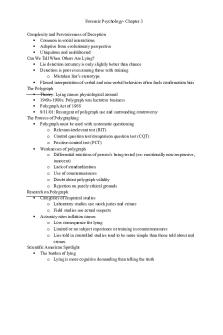Psychology Exercise 3 Kinesthetic PDF

| Title | Psychology Exercise 3 Kinesthetic |
|---|---|
| Course | Introduction to General Psychology |
| Institution | Kennesaw State University |
| Pages | 2 |
| File Size | 76.7 KB |
| File Type | |
| Total Downloads | 15 |
| Total Views | 145 |
Summary
For Dr. Neal's class, assignment on Kinesthetic Learning...
Description
Running head: KINESTHETIC LEARNING
1
Kinesthetic Learning and Reflection The Kinesthetic learning style is characterized by its physical necessities when understanding a particular subject. This learning style requires learning by physical action or a direct experience instead of verbally hearing the information or visual reading or writing the material. These types of learners require something such as a physical experience or a relatable example to correlate the desired material to. This is to promote memorization and mastery of the desired concepts. Kinesthetic Learners such as myself use all of the four senses, sight, touch, taste, and smell. This explains why I understand and best respond to hands-on experiences such as field trips or experiments that create memories that I can associate to the material. Trial and error experiences are also extremely helpful for me. Kinesthetic learning is closely related to Benjamin Blooms Taxonony of learning due to its domains that reinforce higher forms of thinking in education by using senses such as mental, physical and emotional senses to learn and understand instead of just memorizing basic information and facts (Clark, 2013; Mojk, 2010). Individuals who are kinesthetic learners are prone to disorganized note taking due to not being able to have concrete or relevant understanding of a topic. In classroom settings where instructors provide materials aurally or visually I like to have and use plenty of examples, illustrations, or photographs used in the lectures to reference back to. For optimal studying and memorization of materials, it is also important for study materials to be consolidated and have them formatted so that they are organized and simple and filled with things to best recall the information. Preparing practice tests and answers are a great method and practical way of studying for kinesthetic learning that I plan on adding to my study routine throughout school.
KINESTHETIC LEARNING
2 References
Clark, D. (2013, May 01). Bloom's taxonomy of learning domains. Retrieved from http://www.nwlink.com/~donclark/hrd/bloom.html Mojk, D. (2010, January 10). Teaching symmetry using kynesthetic learning. Retrieved from http://serc.carleton.edu/NAGTWorkshops/mineralogy/xtlsymmetry/kinesthetics.html...
Similar Free PDFs

Exercise-3 - Exercise problem
- 14 Pages

Exercise Chapter 3
- 13 Pages

ICT502 Lab Exercise 3
- 6 Pages

Ptask-PAGE-3 - exercise
- 2 Pages

Practice Exercise 3 -2021
- 1 Pages

Exercise Physiology Quiz 3
- 6 Pages

Bio 3 Orientation Exercise
- 2 Pages

BEEB1013 A172 Exercise 3
- 29 Pages

Tutorial Exercise NO 3
- 1 Pages

Chapter 3 Exercise
- 5 Pages

Exercise Physiology Exam 3
- 3 Pages

Exercise 3- Bull Runner
- 2 Pages

Exercise 3-Solution
- 2 Pages

Laboratory Exercise 3 - MATH
- 4 Pages

Forensic Psychology Chapter 3
- 3 Pages
Popular Institutions
- Tinajero National High School - Annex
- Politeknik Caltex Riau
- Yokohama City University
- SGT University
- University of Al-Qadisiyah
- Divine Word College of Vigan
- Techniek College Rotterdam
- Universidade de Santiago
- Universiti Teknologi MARA Cawangan Johor Kampus Pasir Gudang
- Poltekkes Kemenkes Yogyakarta
- Baguio City National High School
- Colegio san marcos
- preparatoria uno
- Centro de Bachillerato Tecnológico Industrial y de Servicios No. 107
- Dalian Maritime University
- Quang Trung Secondary School
- Colegio Tecnológico en Informática
- Corporación Regional de Educación Superior
- Grupo CEDVA
- Dar Al Uloom University
- Centro de Estudios Preuniversitarios de la Universidad Nacional de Ingeniería
- 上智大学
- Aakash International School, Nuna Majara
- San Felipe Neri Catholic School
- Kang Chiao International School - New Taipei City
- Misamis Occidental National High School
- Institución Educativa Escuela Normal Juan Ladrilleros
- Kolehiyo ng Pantukan
- Batanes State College
- Instituto Continental
- Sekolah Menengah Kejuruan Kesehatan Kaltara (Tarakan)
- Colegio de La Inmaculada Concepcion - Cebu
